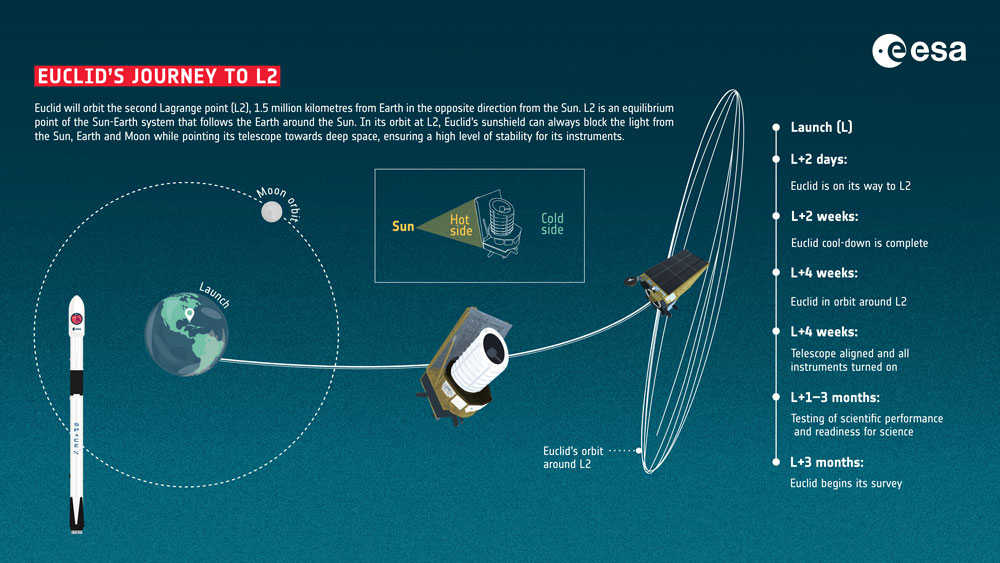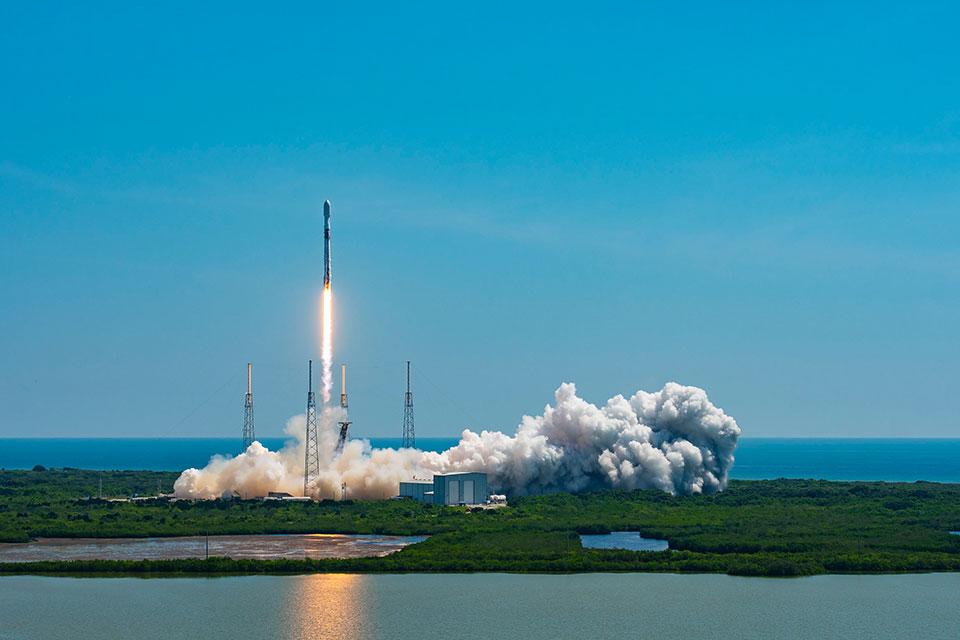The European Space Agency's (ESA) Euclid flagship Dark Energy Satellite Mission successfully launched from Cape Canaveral in Florida on Saturday 1 July 2023. The University of Oxford's Department of Physics plays a key role in the lensing data analysis and has been involved in the mission since its inception.
Euclid’s 6-year mission is to map the dark Universe, using the positions of galaxies and images of dark matter produced from the gravitational lensing distortions of distant galaxies. The galaxy and dark matter maps contain information about the expansion history of the Universe and the evolution of the structure within it. By analysing these maps, astronomers will be able to determine the nature of both dark matter and dark energy. Dark matter, which unlike normal matter does not reflect or emit light, binds together galaxies creating the environment for stars, planets and life, while dark energy is the mysterious new phenomenon which is pushing galaxies away from each other and causing the expansion of the Universe to accelerate.
1.5 billion galaxies
To achieve this, the Euclid consortium team will carry out a very precise and accurate analysis of the images and distances of 1.5 billion galaxies over one-third of the sky. Gravitational lensing causes a one part in a hundred change in these galaxy images, which need to be measured from the sample to a precision of one part in a hundred-thousand, presenting a major data-analysis challenge. Euclid will also measure the spectrum of light from over 35 million galaxies to accurately measure their distance from Earth.
To carry this out the Euclid satellite hosts two state-of-the-art instruments, an optical camera (VIS) built in the UK, and a near-infrared (NISP) camera led by France. The VIS instrument will take images as sharp as those from the Hubble Space Telescope (HST) to measure the gravitational lensing distortions. The NISP instrument will take multicolour images and the spectrum of light of galaxies from which their distance can be measured. Euclid’s wide field of view and large instruments will allow it to image more area of sky in one day than HST in its first 25 years.
Scanning the sky
After launch, Euclid will travel over 1 million miles into space away from the Sun, where the combined gravity of the Sun and Earth will cause it to orbit the Sun once a year, in step with the Earth. It will scan the sky and send many petabytes of data back to ESA’s ground stations. From there Euclid’s data is distributed across nine Euclid Science Data Centres located in Europe, and one in North America. The UK’s Science Data Centre is hosted in Edinburgh. The data centres will process the Euclid data, along with data from complementary ground-based astronomical surveys, day and night, ready for teams of scientists to work on, with the results released to the public.
To realise Euclid’s ambitious mission, more than 2,000 scientists from Europe, including many from the UK, along with the European Space Agency and industrial teams, have assembled to design and build Euclid, and to analyse the data from it. The UK has been involved in the design and building of Euclid from its earliest days, co-leading the teams defining the science programme and observational strategy, leading the construction of the VIS Instrument, leading the gravitational lensing data analysis and production of its high-level data products, and coordinating the science analysis for Euclid, along with many other roles.
Exploring the dark side of the universe
Oxford’s Department of Physics has played a significant role in the lensing data analysis. As well as contributing to the development of the method used to measure the lensing signal, we have specialised in correcting for the effects that the telescope and imaging detectors have on the data. No telescope system is perfect – there is always some blurring and distortion of the images – and Oxford’s role has been not only to build the software models but also to devise ways of calibrating those models using dedicated in-orbit data from Euclid. These are crucial steps that allow the lensing measurements to be used to explore the dark side of our Universe.
Professor Lance Miller leads the work at the University of Oxford: ‘This is an incredibly exciting time. This space mission is the result of years of work and for us here in Oxford, that work continues as we put the finishing touches to the software that will be analysing some of the first Euclid data sent back to Earth, from August onwards. I have been working on Euclid since its inception, so to have reached this major milestone is extraordinary. It is fantastic to be part of a mission that could play a fundamental role in our understanding of the universe.’
As well as aiming to answer some of science's most fundamental questions about the nature of the Universe, Euclid is set to revolutionise studies across all of astronomy, providing a lasting legacy database for professional astronomers and the public to explore.


